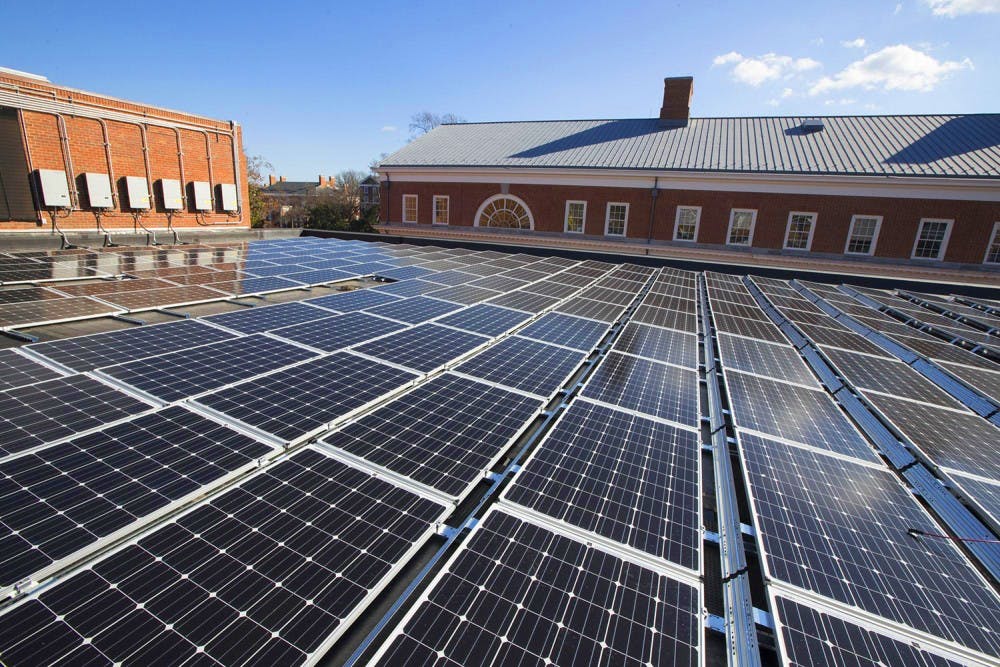Nitrogen pollution — which is caused by excess nitrogen in the air and water — is one of the largest environmental problems in the U.S., according to the Environmental Protection Agency. To begin to combat the surplus of nitrogen, University researchers have created the N-Calculator, the world’s first virtual model to calculate nitrogen usage and emissions.
Nitrogen makes up about 78 percent of the Earth’s atmosphere, and it is an essential nutrient for biological organisms as an amino acid that helps make protein. The majority of nitrogen exists as a harmless, inert diatomic gas. However, once separated, the nitrogen atoms become reactive.
“It’s very difficult to break those atoms up, but once they do, they become very biologically reactive,” Environmental Sciences Prof. James Galloway said. “It can become chemically reactive — it’s [a] major component in smog, in eutrophication and a variety of other environmental problems . . . For example nitrous oxide is a greenhouse gas that can be formed through such reactions.”
Human activity — often attributed to the burning of fossil fuels and food production — generates four to five times more reactive nitrogen than natural processes do.
To spread awareness of the overabundant production of nitrogen, Galloway and Allison Leach, a former College graduate student, developed nitrogen footprint models in 2009 for Leach’s thesis. These models also contributed to the N-Print project — an international collaboration between the U.S. and the Netherlands to reduce nitrogen pollution. Supported by a grant from the EPA, the project has inspired the University’s Board of Visitors to set a nitrogen footprint reduction goal of 25 percent by the year 2025.
The nitrogen footprint models are made accessible to all in website form. The N-Print website answers frequently asked questions about nitrogen pollution, introduces viewers to the purpose of the model and contains a program to calculate the nitrogen footprint of any individual, institution or country.
“The way the project developed is we wanted to have a tool that consumers could use, or institutions could use, that told them how their use of resources — nitrogen, food and energy — contributes to nitrogen pollution in the environment,” Galloway said. “It also gives them a tool to learn about how to then reduce usage.”
A nitrogen footprint is calculated through an equation that measures the amount of reactive nitrogen lost to the environment from food intake and energy usage.
“A nitrogen footprint is the amount of reactive nitrogen released to the environment from resource consumption. The main factors are food and energy,” Leach, who is currently a University of New Hampshire doctoral candidate, said in an email statement. “The food nitrogen footprint includes two parts — the nitrogen released upstream during the production of food (e.g. fertilizer runoff, processing wastes, manure losses) and the nitrogen contained in food that is consumed, which ultimately enters the sewage stream. The energy nitrogen footprint includes the nitrogen emissions released from energy consumption, such as electricity usage or transport.”
Contingent on consumption, the value of an individual’s nitrogen footprint can increase or decrease with a change in diet.
“I could reduce my nitrogen footprint by cutting down on the amount of animal protein I eat. And especially, only eating the amount of protein a person needs,” Galloway said. “We only need a set amount of protein to maintain our bodies, but the average American consumes about 40 percent more than they need.”
Likewise, institutions can decrease their nitrogen footprint by purchasing fewer meat products and by conserving energy.
“There are also things the University can do to reduce energy use, like switching out the light bulbs,” said Elizabeth Castner, project manager of the University’s institution-level nitrogen footprint project and Environmental Sciences research associate. “When they build new buildings, having environmental standards like a LEED Certification can help, so that they are energy-efficient buildings. Another thing is to switch to fuel and energy sources that are less nitrogen intensive, so switching away from coal — which we still use in our heat plant on campus — to natural gas, which has a lower nitrogen footprint.”
Since N-Print’s inception, the University’s nitrogen footprint has been reduced. According to the 2015-16 University Sustainability Annual Report, the amount in metric tons of University-affiliated nitrogen emissions has decreased by 11 percent between 2010 and 2014.
Aside from adding a carbon footprint component to N-Calculator, other areas of improvement can also be made for the tool in the future.
“There are a lot of ways it can be improved,” Galloway said. “We know what these improvements are and most of them require [the tool] to become more complicated. But we’re wanting to develop a tool that focuses on the consumer — it’s easy to use, gives them an opportunity to see how they’re using their resources that result in nitrogen pollution.”
N-Print is just one of many sustainability projects the University has implemented recently.
“[The University] has four solar photovoltaic installations on Grounds, and is working on a roadmap to identify potential locations for additional renewables,” Andrea Trimble, director of the University’s Office for Sustainability, said in an email statement. “Solar panels are installed on Ruffner Hall, the [University] Bookstore, Clemons Library and Skipwith Hall.”
The Delta Force program — the Office for Sustainability's initiative for building sustainability — has also introduced changes to the University. Since utilities usage makes up over half of the University’s nitrogen footprint, the Delta Force program has been especially focused on reducing energy consumption while increasing efficiency in utility plants and buildings. These efforts have reduced greenhouse gas emissions, improved energy conservation and decreased the University’s nitrogen footprint.
Trimble reminds that students, faculty and researchers alike can undertake the task of bettering the environment.
“Every individual and team at [the University] has a role in advancing sustainability,” Trimble said. “As we all have opportunity to ask ourselves how to reduce the environmental impacts of our daily decisions — such as minimizing waste, diverting waste from landfills and looking for opportunities to save energy and water.”







